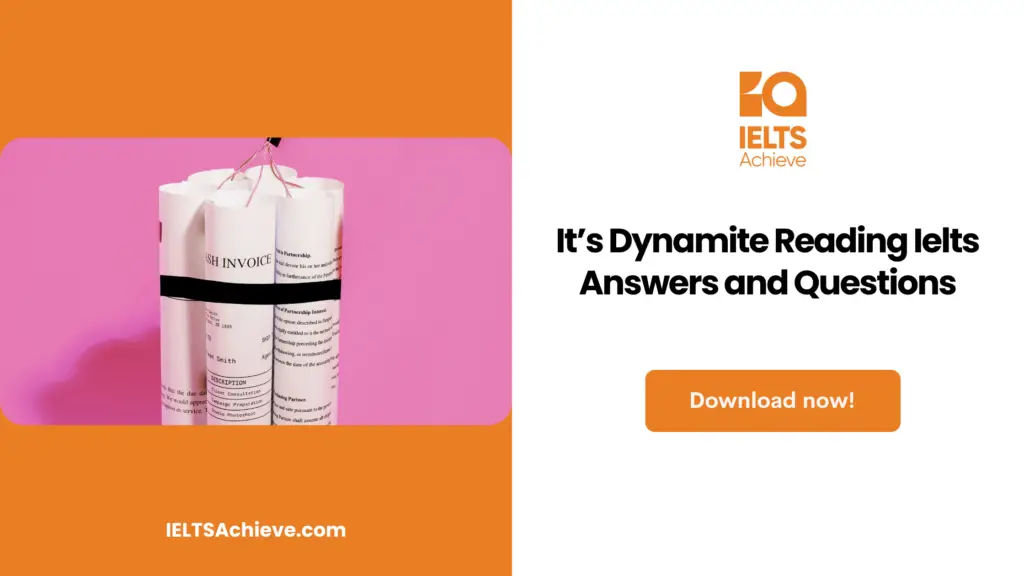The Blog post contains the following IELTS Reading Questions
- IELTS reading locating information
- IELTS reading summary completion
- IELTS reading short answer question
Stay informed and prepared for success – Explore our comprehensive Reading Test Info page to get valuable insights, exam format details, and expert tips for mastering the IELTS Reading section.
IELTS Reading Passage: Could urban engineers learn from dance

Could urban engineers learn from dance
The way we move around cities has a significant influence on their sustainability. Transportation is projected to account for 30% of energy consumption in most of the world’s most industrialized countries, therefore reducing the demand for energy-consuming automobiles is critical for reducing mobility’s environmental effect. However, as more people relocate to cities, it is critical to consider alternate forms of sustainable mobility. The modes of transportation we use have an impact on our physical and mental health, our social life, our access to jobs and culture, and the air we breathe. Engineers are entrusted with transforming how we travel around cities through urban design, but the engineering profession continues to work on the assumptions that led to the establishment of the energy-consuming transportation systems we presently have: the emphasis on efficiency, speed, and quantitative data. We need drastic reforms to make city travel healthier, more fun, and less harmful to the environment.
Some of the solutions may be found in dance. That is not to say that everyone should dance their way to work, no matter how healthy and joyful it makes us; rather, the methodologies used by choreographers to experiment with and create movement in dance might give engineers tools to spark new ideas in city-making. Richard Sennett, a prominent urbanist and sociologist who has revolutionized notions about how cities are built, contends that since the advent of the architectural plan, there has been a split between mind and body in urban architecture.
Building designs are now conceived and stored in media technologies that insulate the developer from the physical and social realities they’re creating, whereas medieval builders extemporized and acclimated construction through intimate knowledge of accouterments and particular experience of point conditions. While these new technologies’ design techniques are critical for handling the technological complexity of the contemporary city, they have the disadvantage of simplifying reality in the process.
Sennett, for example, highlights the Peachtree Center in Atlanta, USA, a development characteristic of the 1970s modernist approach to urban planning. Peachtree designed a grid of streets and skyscrapers to serve as Atlanta’s new pedestrian-friendly downtown. According to Sennett, this failed because its creators placed too much trust in computer-aided design to predict how it would work. They failed to consider that purpose-erected road cafés couldn’t operate in the hot sun without the defensive canopies common in aged structures, and would rather bear energy-ferocious air exertion, or that its massive car park would feel so unwelcoming that people would be discouraged from getting out of their cars. When what appears to be totally predictable and controllable on screen is transferred into reality, the outcomes are unanticipated.
The equivalent exists in the field of transportation engineering, where prototypes are used to forecast and transform the ways individuals move around metropolitan areas. Again, these models are vital, but they are based on certain world views that prioritize efficiency and safety over other aspects of city life. In practice, designs that look rational in models appear counter-intuitive to their consumers. Guard rails, for example, will be recognizable to anybody who has attempted to cross a British road. They were an engineering solution to pedestrian safety based on models that prioritize traffic movement. On major roads, they typically direct people to specific crossing points and restrict their progress by separating the crossing into two – one for each highway. As a result, crossings feel longer, imposing psychological obstacles that disproportionately affect the least mobile, and pushing others to conduct unsafe crossings to avoid the guard rails. These barriers not only make it more difficult to cross the street; they also divide communities and reduce options for healthy transportation. As a result, many are being removed, generating inconvenience, expense, and waste.
There could have been a better answer if their designers had been given the ability to think with their bodies, like dancers, and envisage how these boundaries would feel. Engineering will need to gain a greater knowledge of why people move in specific ways and how this mobility affects them in order to bring about substantial changes in the ways we utilize our cities. Choreography may not appear to be an apparent solution to this situation. Nonetheless, it shares with engineering the goal of developing movement patterns under spatial constraints. It is an art form that was created almost completely by experimenting with concepts on the body and receiving immediate feedback on how the outcomes felt. Choreographers have a thorough awareness of the psychological, artistic, and physical ramifications of various movements.
Cognitive scientist David Kirsh observed choreographer Wayne McGregor and detailed how he “thinks with the body.” Kirsh contends that by utilizing the body to model outcomes, McGregor is able to envisage solutions that would not be conceivable with solely abstract reasoning. This type of physical knowledge is appreciated in many areas of expertise but has no place in formal engineering design procedures at the moment. Transport engineers might improvise design concepts and get rapid feedback about how they would function based on their own expertise, or they could model designs at full size in the same manner that choreographers experiment with groups of dancers. Above all, students may learn to design for both emotional and utilitarian benefits.
Unlock your full potential in the IELTS Reading section – Visit our IELTS Reading Practice Question Answer page now!
Recommended Questions:
Renewable Energy IELTS Reading Question with Answer
Could urban engineers learn from dance IELTS Reading Questions
Questions 1-6
Reading Passage has seven paragraphs, A-G. Which paragraph contains the following information? Write the correct letter, A-G, in boxes 1-6 on your answer sheet.
- a reference to an unanticipated problem caused by neglecting the climate
- a reference to how transportation affects people’s lives
- why certain people-helping initiatives are being reversed
- a reference to an enticing technique of employing dance that the author does not advocate
- statement of a goal shared by dance and engineering
- a comparison between ancient and modern methods of construction
1. – _____2. – _____3. – _____4. – _____5. – _____6. – _____
Questions 7-10
Complete the summary below. Choose ONE WORD ONLY from the passage for each answer.Write your answers in boxes 7-10 on your answer sheet.
Guard rails were installed on British highways to improve the 7. _______________ of pedestrians while ensuring that the passage of 8. _______________ is not impeded. Pedestrians are directed to access locations and urged to cross one 9. ______________ at a time. Unintended consequences include psychological difficulty in crossing the street, particularly for less 10. ________________ people.
Questions 11-13
Answer the questions below. Choose ONE WORD ONLY from the passage for each answer.
11. Which form of barrier is introduced, causing disproportionate injury to the least mobile and encouraging others to participate in risky crossings to avoid the guard rails?
12. What do the guard rails separate for healthy transportation?
13. Who is well-versed in the psychological, artistic, and physical repercussions of numerous movements?
Could urban engineers learn from dance Reading Answers
1. D
2. A
3. E
4. B
5. F
6. C
7. Safety
8. Traffic
9. Highway
10. Mobile
11. Psychological
12. Communities
13. Choreographers

We hope you found this post useful in helping you to study for the IELTS Test. If you have any questions please let us know in the comments below or on the Facebook page.
The best way to keep up to date with posts like this is to like us on Facebook, then follow us on Instagram and Pinterest. If you need help preparing for the IELTS Test, join the IELTS Achieve Academy and see how we can assist you to achieve your desired band score. We offer an essay correction service, mock exams and online courses.
